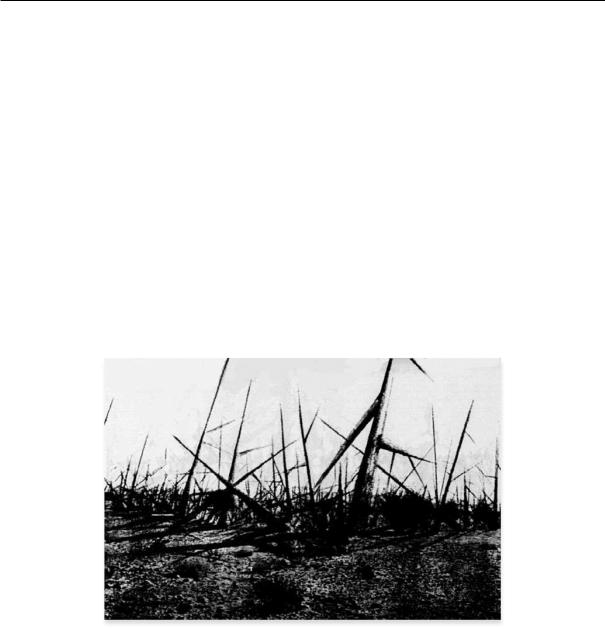
- •Final Report of the RK&M Initiative
- •Foreword
- •Acknowledgements
- •Table of contents
- •List of figures
- •List of tables
- •List of abbreviations and acronyms
- •The glossary of terms of records, knowledge and memory (RK&M) preservation
- •Executive summary
- •Key findings and recommendations
- •Chapter 1. Introduction
- •1.1. Background and scope of the RK&M initiative
- •The formulation of a dedicated initiative under the aegis of the RWMC
- •Modus operandi of the RK&M initiative
- •Key questions and objectives of the RK&M initiative
- •A product and process-oriented initiative
- •The fields of application and target audiences of the RK&M initiative
- •1.2. Evolutions in RK&M preservation thinking: A historical review
- •The RK&M reference bibliography
- •Popular themes in RK&M preservation literature
- •Landscape of Thorns
- •Atomic Priesthood
- •Summary of lessons learnt from the historical review
- •1.3. References
- •Chapter 2. RK&M preservation: Fundamentals
- •2.1. RK&M preservation and its connection to safety
- •The repository: From “seclusion and oblivion” to a societally embedded facility
- •Introducing the concept of oversight
- •2.2. Protecting humans and the environment
- •2.3. Supporting informed decision making
- •2.4. References
- •Chapter 3. RK&M preservation: Challenges and opportunities
- •3.1. Information life cycle management
- •3.2. Causes and consequences of RK&M loss
- •Lessons from RK&M loss in the nuclear field
- •Lessons from RK&M loss outside the nuclear field
- •3.3. RK&M preservation in a regulatory context
- •National RK&M preservation regulation
- •Planning responsibilities over time
- •International soft law
- •Regulation: a necessary condition for RK&M preservation
- •3.5. References
- •Chapter 4. Key characteristics of RK&M preservation approaches and mechanisms
- •4.1. Introducing the idea of a “systemic strategy” for RK&M preservation
- •4.2. Multiple time frames
- •The short term
- •The medium term
- •The long term
- •4.3. Multiple media
- •4.4. Multiple contents
- •4.5. Multiple transmission modes
- •4.6. Multiple actors
- •Multiple disciplines
- •Multiple interests, concerns and roles
- •4.7. Multiple locations
- •4.8. References
- •Chapter 5. RK&M preservation approaches and mechanisms
- •5.1. Introduction to the RK&M preservation “toolbox”
- •5.2. Dedicated record sets and summary files
- •5.3. Memory institutions
- •5.4. Markers
- •5.5. Time capsules
- •5.6. Culture, education and art
- •5.7. Knowledge management
- •5.8. Oversight provisions
- •5.9. International mechanisms
- •5.10. Regulatory framework
- •5.11. References
- •Chapter 6. Towards a systemic strategy for RK&M preservation
- •6.2. Meeting national needs
- •6.3. RK&M preservation starts today – life cycle thinking
- •6.4. RK&M preservation is an ongoing process
- •6.5. RK&M preservation is a participatory process
- •6.6. Illustration: Two fictional examples
- •Fictional example 1
- •Compliance activities
- •Best practice activities
- •Supporting activities
- •Fictional example 2
- •Compliance activities
- •Best practice activities
- •Supporting activities
- •6.7. References
- •Chapter 7. Conclusions and outlook
- •7.1. Conclusions
- •Embedding disposal facilities in society
- •Preventing inadvertent human intrusion and supporting informed decision making over time
- •Developing a systemic strategy for RK&M preservation
- •The importance of multi-disciplinarity and participation
- •7.2. Outlook
- •Upholding and elaborating an open and holistic attitude
- •Creating awareness, supporting engagement and starting RK&M preservation today
- •Developing international collaboration
- •7.3. Reference
- •Annex 1. RK&M glossary
- •Archive
- •Awareness
- •Control
- •Composite expressions
- •Cultural heritage
- •Data
- •Information
- •Knowledge
- •Composite expressions
- •Long term
- •Marker
- •Mediated/non-mediated transmission
- •Medium term
- •Memory
- •Message
- •Monument
- •Oversight
- •Record
- •Redundancy
- •Short term
- •Stakeholder
- •Systemic strategy
- •Very short term
- •References
- •Annex 2. Descriptions of RK&M preservation mechanisms
- •2.1. Mechanism description sheet: template
- •2.2. Mechanism description sheets
- •Dedicated record sets and summary files
- •Key information file (KIF)
- •Set of essential records (SER)
- •Memory institutions
- •Archives
- •Libraries
- •Museums
- •Markers
- •Surface markers
- •Monuments
- •Sub-surface markers
- •Deep geological markers
- •Surface traces
- •Time capsules
- •Large visible time capsules
- •Large invisible time capsules
- •Small time capsules
- •Culture, education and art
- •Industrial heritage
- •Alternative reuse of the disposal site/infrastructure
- •Heritage inventories and catalogues
- •Local history societies
- •Intangible cultural heritage
- •Education, research and training
- •Public information dissemination activities
- •Knowledge management
- •Knowledge retention tools
- •Knowledge risk analysis
- •Knowledge sharing philosophy
- •Oversight provisions
- •Monitoring
- •Land use control
- •Clear and planned responsibilities
- •International mechanisms
- •International regulations and agreements
- •International standards and guidelines
- •International inventories and catalogues
- •International co-operation
- •International education and training programmes
- •International archiving initiatives
- •Regulatory framework
- •National regulatory framework
- •Safeguards
- •2.3. Mechanisms overview table
- •Annex 3. Deliverables of the RK&M initiative
- •Workshop and conference proceedings
- •Studies
- •Reports
- •Website
- •Annex 4. Members and participating organisations of the RK&M initiative
- •NEA PUBLICATIONS AND INFORMATION

INTRODUCTION
Documents in the first group, with the IAEA as an important author, notably deal with knowledge management and record systems, with a focus on the needs of the nuclear industry in the short term. They often contain analyses of a fairly detailed and specific nature of the kinds of information needed and how that information should be collected and organised.
On the other hand, documents in the second group, the main group of interest for the RK&M initiative, are often more theoretical and more abstract. This finding perhaps reflects the fact that most geological repository programmes have not yet reached the point of implementation and have therefore not yet felt the need to develop practical methods for preserving RK&M across generations. This finding guided the work of the RK&M initiative and confirmed the idea of having an inspirational “toolbox” or “menu” of practical mechanisms for RK&M preservation as one of the important outcomes of the initiative (see Chapters 5 and 6 and Annex 2.2/2.3 with the mechanism description sheets).
The majority of documents in the bibliography thus deal with either the short, operational term, or with an undefined, hypothetical long term. Relatively few documents attempt to cover both areas of interest, or to bridge them (by elaborating what the RK&M initiative refers to as “the medium term”). For example, limited work was available on themes such as contextualising data for later use, systematic identification of mechanisms for RK&M transfer over different timescales, or the transfer of responsibilities over time.
The analysis of the bibliography also revealed specific topics that have not been widely addressed in previous literature (see also NEA, 2013: pp. 51-56). These topics include costs and funding for activities related to RK&M preservation (see Section 3.4 on costs and funding), the role of actors other than implementing agencies and regulators in RK&M preservation (such as non-governmental organisations, local communities and private bodies) (see Section 4.6 on actors), the role of monitoring in both the creation and preservation of RK&M (see Section 5.8 on oversight provisions), and security and safeguards as motivations for preserving RK&M (see Section 5.10 on the regulatory framework).
Lastly, an inspection of the abstracts ordered by date (ranging from the 1970s and 1980s to the present) suggested that there has been a change in emphasis, or more broadly, a change in the rationale for RK&M preservation across generations. Traditional approaches were based on the premise that safety was best assured by avoiding societal interest in the disposal facility. RK&M preservation mechanisms were designed to enforce this premise, such as land use restrictions enforced by fences for the shorter term and warning markers for the longer term. In recent years more thought has been dedicated to dynamic mechanisms that involve society, such as conditional reuse of sites and active participation by local communities in decision making. Moreover, the idea of “dictating” the future has lost ground in the literature. A more present-day thought is that rather than attempting to manipulate the emotions of future generations, RK&M preservation mechanisms ought to try to simply inform those generations (A. Van Luik in NEA, 2012: pp. 88-89; see also Chapter 2 on fundamentals).
Popular themes in RK&M preservation literature
The broad theme of “how to inform the future about our radioactive waste” sporadically appears in more popular literature and other media, such as opinion pieces, reportages or commentaries in magazines, newspapers, blogs, documentaries and films.13 Certain themes from the past persistently reoccur in such media, such as the Landscape of Thorns, the Atomic Priesthood and the Ray Cat. They have their origins in literature covered in the RK&M bibliography, but the broader content of these often voluminous sources is habitually omitted in popular media.
13.To give some examples encountered throughout the RK&M project’s duration: the films “Into Eternity” (M. Madsen, 2010) and “Containment” (R. Moss and P. Galison, 2015); www.theguardian.com/environment/ shortcuts/2017/jan/08/colour-changing-cats-warn-radioactive-waste-nuclear-plants-distant-descendants; www.damninteresting.com/this-place-is-not-a-place-of-honor; http://mentalfloss.com/article/27476/ray- cats-artificial-moons-and-atomic-priesthood-how-government-plans-protect-our (last accessed in February 2018).
PRESERVATION OF RK&M ACROSS GENERATIONS: FINAL REPORT OF THE RK&M INITIATIVE, NEA No. 7421, © OECD 2019 |
21 |

INTRODUCTION
Landscape of Thorns
The majority of the US documents in the RK&M bibliography relate to the Waste Isolation Pilot Plant (WIPP), a currently operational deep geological disposal facility in the state of New Mexico. When the WIPP was conceived in the 1980s, two dedicated multidisciplinary panels were convened by the United States Department of Energy. The first panel focused on future inadvertent human intrusion scenarios (the “Futures Panel”, see Hora et al., 1991), the second used the insights from the first on markers (the “Markers Panel”, see Trauth et al., 1993). Their core recommendation was a dire warning in a number of languages and symbolic warning objects. The panels were insistent on ominous markers and messages conveying a negative tone to cause fear or foreboding (A. Van Luik in NEA, 2012: pp. 88-89). The “Landscape of Thorns”, a concept to cover the future WIPP site with giant spikes sticking out in odd directions, remains one of the most illustrative and well-known examples of this approach (see Figure 1.2). A direct communication mode was sought that is “non-linguistic, not rooted in any particular culture, and thus not affected by the expected certain transformation of cultures” (Trauth et al., 1993: p. F-49). The tone for the entire landscape was meant to be non-natural, ominous and abhorrent (“This place is not a place of honor”, “What is here is dangerous and repulsive to us”). Future generations were thus notably conceived as “potential intruders”, and the question “How will we protect future generations?” consequently translated to “How to warn them off the site?” (Benford, 2000).
Figure 1.2. Landscape of Thorns
Source: Concept by Michael Brill and art by Safdar Abidi (Trauth et al., 1993: p. F-61).
Perhaps because the reports of the panels are so rich in definite and often rather spectacular proposals, there is a risk of overlooking their more generic insights, the grounding thoughts behind the various marker proposals. For one, the recommendation was formulated to create not one sole marker, but a “marking system”. By this, the panellists meant a combination of message levels, marking system components, materials and modes of communication in which the “components relate to one another in such a way that the whole is more than the sum of its parts” (Trauth et al., 1993: p. F-11). More generally, a “systems approach” was defended, “where the various elements of the communications system are linked to each other, act as indexes to each other, are co-presented and reciprocally reinforcing” (Trauth et al., 1993: p. F-33). This approach was found fundamentally valuable within the RK&M initiative and was elaborated beyond the mechanism of on-site markers alone (see Annex 1 and Chapter 6).
Another key concept in the Marker Panel’s report found pertinent within the RK&M initiative is redundancy. The panel defined this concept as an RK&M preservation strategy “where some elements of the system can be degraded or lost without substantial damage to the system’s
22 |
PRESERVATION OF RK&M ACROSS GENERATIONS: FINAL REPORT OF THE RK&M INITIATIVE, NEA No. 7421, © OECD 2019 |

INTRODUCTION
capacity to communicate” (Trauth et al., 1993: p. F-33). It was further stipulated that redundancy, important to message survivability, should be achieved through: (a) a high frequency of message locations, permitting some to be lost; (b) making links among message levels; and (c) multiple and mutually reinforcing modes of communication (Ibidem: p. F-50).
Atomic Priesthood
Perhaps one of the first references to the challenge of RK&M preservation dates back to 1972, when the well-known nuclear engineer A. Weinberg connected nuclear energy to a demand for “a vigilance and a longevity of our social institutions that we are quite unaccustomed to” (Weinberg, 1972: p. 33). Weinberg introduced the notion of a long-term nuclear “priesthood”, albeit in the context of long-term safeguards (Ibidem: p. 34). This concept was later developed further and applied to long-term RWM by Th. Sebeok, a semiotician and linguist who was one of the consultants within the “Human Interference Task Force”. Convened by the US DOE in 1981, this was the first multidisciplinary panel (preceding the Futures and Markers panels) tasked to find ways to reduce the likelihood of unintentional intrusion, focusing on the proposed Yucca Mountain disposal site. The task force consultants concentrated on long-term communication and established the field which would become known as “nuclear semiotics”, with Sebeok as a leading figure.14
Sebeok imagined a system of “legend-and-rituals” around an “Atomic Priesthood”, whose task it would be to keep the knowledge of nuclear waste alive yet secret. The idea comes down to creating superstition among the “uninitiated” and reserving the truth about the disposal site for a “priesthood” of academics, which would select its own members as a self-perpetuating intellectual oligarchy (Wikander, 2015: p. 115). As Sebeok explained:
The legend-and-ritual […] would be tantamount to laying a “false trail”, meaning that the uninitiated will be steered away from the hazardous site […]; essentially, the reason would be accumulated superstition to shun a certain area permanently. […] The actual “truth” would be entrusted exclusively to – what we might call for dramatic emphasis – an “atomic priesthood”, that is, a commission of knowledgeable physicists, experts in radiation sickness, anthropologists, linguists, psychologists, semioticians, and whatever additional expertise may be called for now and in the future. Membership in this "priesthood" would be self-selective over time. (Sebeok, 1984: p. 24)
Unsurprisingly, Sebeok is principally remembered for his “nuclear priesthood” notion. He developed two other ideas that were found to be of more relevance within the RK&M initiative. Sebeok recommended a “relay system”, “dividing the 10 000 year epoch envisaged into manageable segments of shorter, and presumably, reasonably foreseeable periods” planning no more than three generations ahead and including a plea for updates (Sebeok, 1984: p. 26). In his legend-and-ritual approach, Sebeok also recommended redundancy by deploying both written and oral traditions, and more generally, “as many stable systems and devices be utilised as imagination suggests and technology permits” (Ibidem: p. 21).
14.Sebeok first coined the notion of “nuclear priesthood” in the Human Interference Task Force sub-report “Communication Measures to Bridge Ten Millennia” (Sebeok, 1984: notably pp. 24-28). Upon the publication of the final report of the task force (Human Interference Task Force, 1984), interest in “nuclear semiotics” grew and spread. In 1984, the German journal Zeitschrift für Semiotik (Journal of Semiotics) published a special edition with a dozen responses from academics to a poll asking how to communicate across 10 000 years (“Und in alle Ewigkeit: Kommunikation über 10 000 Jahre: Wie sagen wir unsern Kindeskindern wo der Atommüll liegt?” [“And into Eternity... Communication over 10 000s of Years: How Will We Tell our Children’s Children Where the Nuclear Waste is?”] (www.semiotik.tu- berlin.de/menue/zeitschrift_fuer_semiotik/zs-hefte/bd_6_hft_3). Sebeok contributed to the journal with his most known article “Die Büchse der Pandora und ihre Sicherung: Ein Relaissystem in der Obhut einer Atompriesterschaft” [“Pandora’s box and its protection: A relay system in the care of an atom priesthood”]. It became further known when published in a book edited by R. Posner in 1990: Warnungen an die ferne Zukunft – Atommüll als Kommunikationsproblem (Warnings to the Far Future – Atomic Waste as a Communication Problem) (Posner, 1990).
PRESERVATION OF RK&M ACROSS GENERATIONS: FINAL REPORT OF THE RK&M INITIATIVE, NEA No. 7421, © OECD 2019 |
23 |
